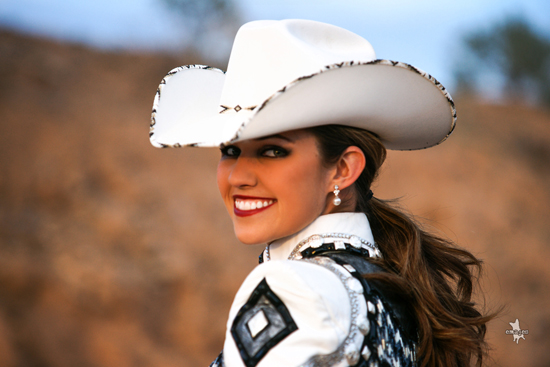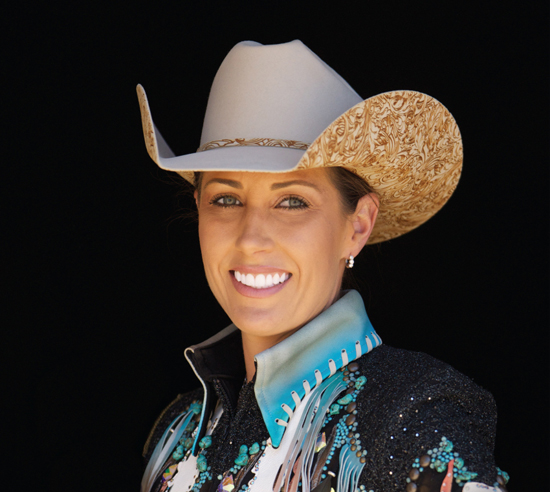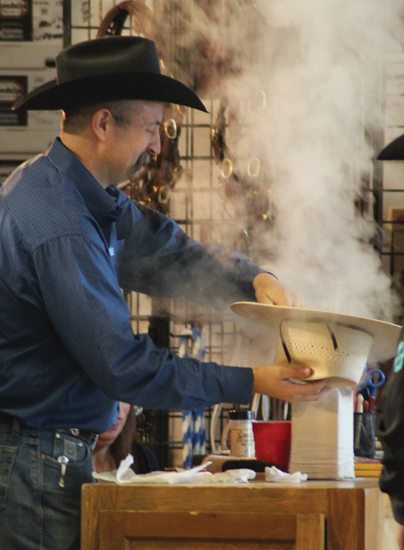 It’s been said that a western hat speaks volumes about the person wearing it. The height and crease of the crown and the size and shape of the brim provide clues to the wearer’s event of choice. Color and accents offer insight into the rider’s personality and style.
It’s been said that a western hat speaks volumes about the person wearing it. The height and crease of the crown and the size and shape of the brim provide clues to the wearer’s event of choice. Color and accents offer insight into the rider’s personality and style.
In the show pen, the western hat is an essential piece of the exhibitor’s gear. It demonstrates confidence, commitment and attention to detail.
“When our clients enter the show pen, I want everyone on the rail to say WOW, look how that hat looks with that outfit,” said Lavonna, a.k.a Shorty, Kroger, owner of Shorty’s Caboy Hattery in Oklahoma City, Oklahoma.
A basic, well-shaped black hat never goes out of style. It’s appropriate in any class and coordinates with any outfit. But, today’s riders have more options than ever to select a hat that makes a statement.
“There are so many options to choose from. Our goal is to help customers choose the best quality hat within their budget,” said Barbara Maitia, owner of Barbara’s Custom Hats in Fort Worth, Texas.
There is hardly an image of a cowboy or cowgirl without a western hat perched on top of his or her head. Western hats are as old as the folklore that accompanies the cowboy.
 Although the western hat is a traditional and required piece of an exhibitor’s show attire in western rail and performance classes, they are far from the old-fashioned ten gallon hat of the old-West.
Although the western hat is a traditional and required piece of an exhibitor’s show attire in western rail and performance classes, they are far from the old-fashioned ten gallon hat of the old-West.
In the 1970s the “taco” style hat adorned most rider’s heads at breed shows around the country. The “U” shaped brim was rounded in both the front and the back, literally making the hat look like a taco. Pastels, gold and Silverbelly were the most popular colors of the time.
By the early 80s the “Urban Cowboy” look illustrated by country singer, Mickey Gilley, influenced style and color. The hats had a higher crown, shorter brim and feathers. As the late 80s melted into the 90s, rodeo champion, Larry Mahan, and country artist, George Strait, soared in popularity. They brought with them a preference for hats with a higher crown and a wide, flat brim.
“Leather bands with silver Conchos or horsehair hatbands were popular accents then,” Maitia said.
As the 20th century came to a close, trends shifted again and a preference for hats with a slightly lower profile and slight rodeo crease became popular. Black, Silverbelly and the neutral shade, buckskin, were the color of choice.
“These hats were all great quality and later proved to last for many years,” she said.
Hats shaped with the Quarter Horse crease and a square shaped brim in natural, earthy tones ushered in the new millennium.
“In 2010, I brought hats to the American Quarter Horse Youth World Show with a much higher and tighter crease that sharpened the profile and defined the look of the hat,” Maitia noted, “customers quickly embraced the fashion forward crease and it proved trendy when modified to look like a higher and tighter Quarter Horse crease.”
The Quarter Horse and Congress creases are still popular options today. Some riders opt for the higher, tighter, West Coast hat for Showmanship, Horsemanship and Western Pleasure. “This shape should not be confused with the “taco” shape, and if done properly, is flattering and feminine for the ladies,” Maitia said.
Today, hat makers are pairing trendy accents with timeless hat shapes to help riders create a unique, attention getting look in the show pen.
“The cattleman’s crease has been the most popular and the crowns are a little lower than they used to be,” said Brook Parrish, who owns and operated Kendalls Western Hats in Pavo, Georgia. “Men are choosing a bit wider crown, but we’re keeping the women’s fairly close on top.”
 From buck stitching, crystals, animal bound edging and beaded edges to hides and laser hand-cut engravings, the choices are endless.
From buck stitching, crystals, animal bound edging and beaded edges to hides and laser hand-cut engravings, the choices are endless.
These customizations nearly guarantee that no two riders will have the same hat. “When hats are custom made by hand, no two hats are ever alike,” said Kroger, “laser cutting is done by hand, color, texture and hides can vary so they may be similar, but not the same.”
Even colored hats are finding their way back into the arena and have been quite popular the past few years. “It’s important to be age appropriate and have the colors carefully matched,” Maitia added, “it’s not a pretty picture if the hat is off color or poorly paired with another color.”
“Black is always in so I see a lot of that,” Parrish said. “Dark grey and a dark tan/light brown are very popular right now.”
Ultimately, hat choice is a matter of opinion, taste and personal style. However, it’s important to know the preferred trend for specific events. “The Showmanship and Horsemanship competitors are more conservative and traditional,” Kroger explained.
Exhibitors in Western Pleasure, Trail and Western Riding events have a bit more flexibility in hat selection. “It all depends on their outfit, but these riders can express their individual styles a bit more,” she said.
In recent years, Trail and Western Riding classes have taken on a more casual, almost retro, look with plain, button down shirts, scarves and a more intricately detailed hat.
 Color selections vary among disciplines and the current trend often changes so quickly that it can be difficult to keep up from one season to the next. At the end of 2015, gun metal, steele and granite grey, Whiskey gold, olive pecan and colored hats filled the World Championship show pens.
Color selections vary among disciplines and the current trend often changes so quickly that it can be difficult to keep up from one season to the next. At the end of 2015, gun metal, steele and granite grey, Whiskey gold, olive pecan and colored hats filled the World Championship show pens.
“Not every shape or color looks great on everyone,” Maitia emphasized, “it’s better to pick a hat that compliments your skin tone, matches the color scheme of your outfit, looks good with your horse’s coat color and fits properly.”
Parrish agrees. “Some people want a hat to match the trend, but that trend doesn’t always match that person’s features,” he said. “It’s better to have a hat that complements your features. You want to fit it and have the hat look good on you.”
At the end of the day, a hat should complement and “complete” a winning look rather than create a distraction.
Purchasing a hat for breed shows is an investment. Entry level hats averaging $100 are readily available. Inexpensive felt hats require reshaping after every show and do not offer the same rich appearance as higher quality beaver felt hats. The internet is full of “bargains” or clearance hats, but beware you may fall victim to inheriting an out-of-style or ill-fitting hat nightmare.
Hats that fall in the “mid-range” average $300-$400. These hats are richer in color, hold their shape better and are intended to last.
“There is no real industry standard when it comes to quality,” Maitia said, “one must know and trust their hat maker and do their homework.”
It’s true, you get what you pay for. Kroger encourages clients to purchase a 50x beaver blend, which averages $700-$800 or more.
“If you buy good quality, it will last longer and keep its shape,” she said.
If your budget allows and you can afford the best quality hat, expect to pay upwards of $750 for a pure beaver hat. Each hat company has their respective prices, but one can generally expect to pay $750-$1,250 for a 50x and 100x hat.
 “There is no standard X rating,” Parrish said. “You have to trust the person you are buying from that you are getting what you pay for.”
“There is no standard X rating,” Parrish said. “You have to trust the person you are buying from that you are getting what you pay for.”
Hats are typically beaver and rabbit fur blends. Normally the higher the X, the more beaver fur.
“But some companies will sell you a 100 percent beaver fur hat that is not made of the best quality fur from the beaver,” Parrish said. “It comes down to trusting the person you are buying your hat from.”
Straw hats are popular warm-weather showing, economical and can also be customized. Ranging in price from $70-$155 or more for customization, the hats are a short-term option for some riders.
Any hat should fit properly. It’s especially crucial to take the time to achieve proper fit when investing several hundred dollars into a hat intended to last many years. An improperly fitted hat can make a long day uncomfortable, maybe even unbearable.
“Your hat should be snug, but not to the point that it’s squeezing your brains out,” Maitia said.
Ask the experts for help with fit so that you avoid buying a hat that’s miserable to wear, so poorly fitted that it rides too low on your face or too tight that it pops up or flies off your head when you’re riding.
“We measure a rider’s head and do a head shape so we get the perfect fit,” Kroger said, “we want a rider’s hat to be comfortable.”
Choosing a hat that completes your “winning look” in the show pen demonstrates to the judges that you took special time and effort to coordinate all aspects of your “go”.
“I always say if you are tastefully different and can ‘rock it, own it, win it’, then set the trend,” Maitia said. “Have fun with your outfits and it shows that you are not afraid to set the bar a bit higher.”


You must be logged in to post a comment Login